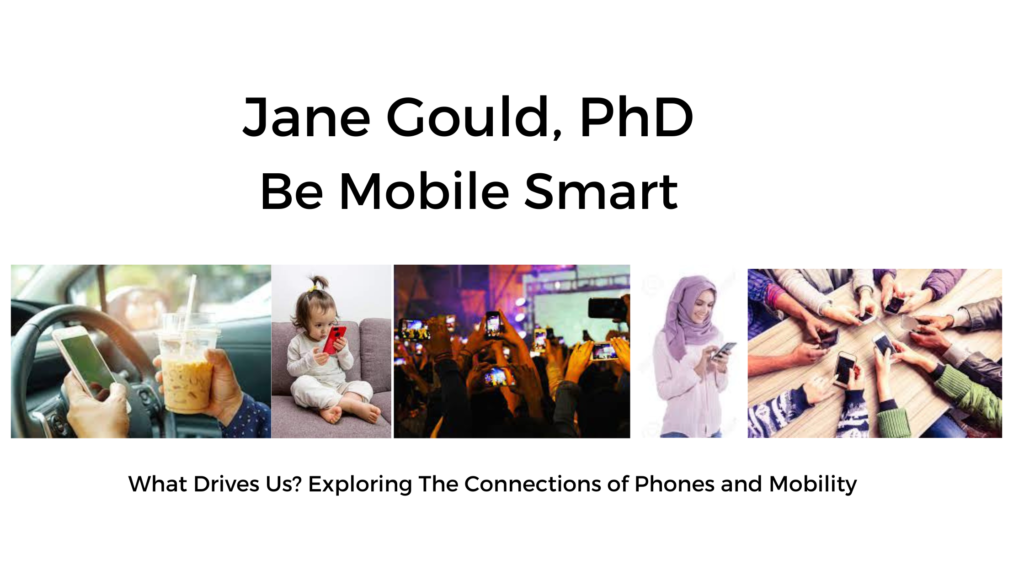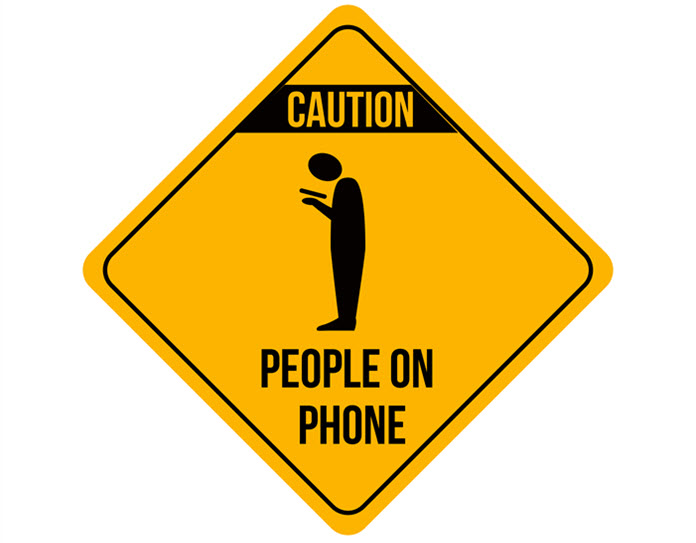Jane Gould, PhD

We all look at our phones throughout the day….but the goal of BeMobileSmart, aka dearsmartphone, is to look at our phones differently, with fresh eyes.
How do phones change our daily habits and how we go about our daily routines? Does content from Instagram, Facebook and other social media change what we think about and how we remember things? And, most importantly, how does a smartphone extend into our personal relationships and social affairs?
BeMobileSmart evolved from the weekly column that began in 2018. It is a new lens into the world of phones and mobility. It is a landing site that brings something new to the conversation.
The awareness that we are distracted by phones in vehicles is vitally important, but our distraction extends to all portions of the day. The average adult picks up their phone about 96 times a day, about once every ten minutes. Tweens and teens find it unnatural to be offline and stay hyper-connected throughout the day. When phones were stationary and tethered to the wall, we were limited to one or two things…. to listen and to talk. The mobility of phones completely changes that. Phones travel with us and that brings us a feeling of personal security and our availability to others. However, this also comes with challenges and stress. Multitasking splits our attention and awareness.
BeMobileSmart is an open conversation about how we manage this, and sometimes how we do not. The site challenges us to see our phones in a new light and manage them better.
“Time well spent” is how users described the DearSmartphone advice column….. now join at BeMobileSmart to take the discussion further and add your questions and comments. It is a user driven site!
www.bemobilesmart.com
No experience necessary…just a curious mind. And, here’s another path to join too.
@dearsmartphone (Instagram)
Smartphones are expressive…particularly when it comes to displaying images and graphics. Instagram needs phones and phones need emojis, graphics, and visual shortcuts. Sometimes images are more powerful than words alone, and can help us to quickly express and grasp the role of smartphones in our daily lives. So, join us on Instagram too.
BeMobileSmart- More than Pretty Pictures
Emojis and cute pictures are expressive in new ways, but also have their limits. You can find more in-depth articles and items at www.dearsmartphone.com dearsmartphone.com
Fast Speed, Slow Needs:
This is a recent piece about traveling with children and their electronic devices. When is it suitable to bring the device along and what happens when children look down, instead of out the window? How does their curiosity change as well as their ability to manage plain old boredom?
Parental Controls for Tween Phones
It is a rite of passage. Today’s tween is likely to have a smartphone by age ten or earlier. Until recently, there was a different rite of passage: reaching the age to get a learner’s permit for driving. What are the similarities and differences between the new mobility for teens and the old mobility in vehicles?
Provisional Phones Meet Digital Literacy
Parents have always taught their children how to eat, when to sleep and how to interact with other people, but today parenting is incomplete without lessons on how to interact with technology. There are valid concerns about the hours kids will spend on their phones, as well as the accidental, or deliberate, exposure to cyber-bullying, cyber-porn, and more. In this piece I suggest a learning tool, a new popular social media site that parents and tweens can use together and share.
Learning from a Fall: “Lady in the Fountain” (the video)
It’s a challenge to convince smartphone users that their devices divide their attention and compromise cognitive faculties. “We know what we see” is a typical response. We are not aware of how our consciousness can be hijacked or dimmed. This video has become a social media classic as it is informative, but is also funny and holds our attention. YouTube cites more than 600,000 views since 2011. The actual Lady in the Fountain (not to be named here) has threatened law suits. But, nearly a decade later, the video continues to be shared. It challenges us to think about the time-less public shaming and humiliation that occurs through social media. The video is readily found in the public domain so I post the link and add a second issue to the discussion. How do we, as individuals, live with the embarrassing moments on social media that become permanent and forever?


Remember, it’s a two-way street…smartphones bring ‘People on Phones’ and ‘Phones on People’. Take time to be present and search in all directions.